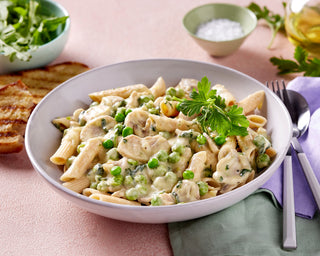
We all know that food is an important part of being healthy at every stage of your life, but when it comes to our later years, what goes in plays a major role in maintaining brain and body function.
In this post, we look at what role food plays in healthy ageing and how to ensure you’re getting what you need.
Why Nutrition is important as we get older
As we age, our bodies gradually being to lose muscle mass, we’re less active and for women menopause may exacerbate muscle loss. When we reach 65 years and over, that midnight craving is non-existent and appetite in general may start to decline, rapid weight loss may occur, and lack of muscle strength may increase frailty. Our brain volume starts to decline and our bodies’ ability to absorb calcium may decrease bone density. Not only that but life happens, and the social aspects of eating may start to fade, our sense of taste, smell and sometimes dental problems may make us think twice about that nice juicy steak.
Overall there are plenty of changes, and before you start freaking out about what’s to come, not all of us are destined for a negative ageing process. Ageing is a beautiful process and we can look forward to what’s to come!
Energy First, Nutrients Second
Undernutrition is not uncommon among the elderly, and it can occur for a range of reasons; some lack the motivation to cook, might struggle with grocery shopping, have a lack of appetite or feel full a lot quicker. All of which can lead to an impaired immune system, frailty, osteoporosis, lower quality of life and more prolonged and frequent hospitalizations1
That’s why maintaining weight becomes a priority and forms the number one recommendation of the Australian Dietary Guidelines for the elderly – i.e.
“Maintain a healthy weight, be physically active and choose foods and drinks to meet energy needs”
Instead, carrying a little extra weight can offer some benefits, such as decreasing the risk of fractures, increasing bone density, assisting with oestrogen production and may even offer immune benefits too. So yes Nanna, please enjoy another slice of cake!
Something to note with this is that it shouldn’t be confused with carrying excess weight which can lead to more hazardous health outcomes. Carrying a little extra weight is intended to address undernutrition only, gradual weight gain is recommended and we always recommend getting advice from an so they can guide you when gaining, losing or maintaining weight.
If energy intake and weight is not a concern, then nutrient intake becomes the next priority. Protein, calcium, vitamin D, fibre and water requirements increase as we age and can be achieved through the second recommendation -
“Enjoy a wide variety of nutritious foods from the five foods groups”
Protein
As you get older, your Protein needs increase by 20 - 25%.
The World Health Organisation recommends intakes at 0.9 – 1.1g/kg per day.
Choose foods like minced beef, fish, poultry, eggs, nuts and soybeans to meet your nutritional needs. Whey protein added into nanna’s pasta dishes, her custard, or stew is also a great way to help ensure protein needs are met.
Calcium, Vitamin D and Frailty
Osteoporosis is common among the elderly, which is characterized as mineral loss like calcium occurring faster than what the body can replace them with. With this, fractures of the hip, leg, leg and wrist may also be more common which is why diets that contain calcium are particularly important to protect against further bone loss and increase protein needs. The Australian Dietary guidelines recommends 4 servings of dairy per day for women aged 51 and over and 2.5 servings for men (50-70 years of age).
Some of the best sources include reduced fat milk, cheese, custard, yoghurt, and calcium fortified soy milk.
Vitamin D is also essential to build and maintain healthy bones and prevent osteomalacia. Absorption of vitamin D and lowered outdoor activity may also place the elderly at risk. So a good dose of sunshine on a regular basis is always a good idea (who doesn’t love that?!) and may need to be combined with supplementation for some.
Dietary sources include: fortified cereals, margarine, eggs, cheese, oily fish and dairy products.
Fibre and Water
Fibre and water intake go hand in hand in many respects, but one of the key reasons is that getting enough of both is important as we age is to ensure healthy bowl function.
Wholegrains, wholemeal bread, beans and lentils are full of key nutrients and are also packed with fibre, so getting these into your diet will do wonders.
Hydration can be a tricky one we are less likely to recognise thirst as we age compared to when we’re younger. However, continued fluid intake including tea, coffee, milk or water all count in your daily tally.
Med Diet and Healthy Ageing
Although focusing on key nutrients are important as we age, experts are now agreeing that focusing on dietary ‘patterns’ such as the Mediterranean diet may offer more consistent results as opposed to singling out specific nutrients. This diet involves plenty of vegetables, fruits, grains, beans, moderate fish and dairy, limiting red meat and olive oil as the main source of dietary fat. Supporting this claim, a recent study found that in those aged 65 years and older who followed this diet more closely were associated with prolonged survival. Something to keep in mind even in the later years.

We're Here to Help
Shopping can be difficult for the older generation especially if living alone. With Dineamic you can stock up on great meals and have your favourites ready on hand.
Our customers are especially loving:
- Grass Fed Beef Bolognese with Broccoli and Pasta
- Roasted Grass Fed Beef Fillet and Root Vegetables with Mushroom Sauce
- Chicken Mushroom Risotto
- Grass Fed Beef Lasagne
If you are receiving a Home Care Package or know a loved one currently receiving one, meal deliveries through Dineamic can help support your needs through a subsidized or lowered cost. Get in touch with the Dineamic Team to see how we can assist you in living independently.

Healthy eating and being physically active will keep us healthy as we age – remember to eat well, keep moving and enjoy mealtimes with loved ones whenever you can.
For more information:
- Healthy Eating When You’re Older
- Managing Undernutrition in the Elderly
- Healthy Eating for Older Adults
- Cruz-Jentoft AJ, Baeyens JP, Bauer JM, et al. Sarcopenia: European consensus on definition and diagnosis: Report of the European Working Group on Sarcopenia in Older People. Age Ageing 2010;39:412–23.





